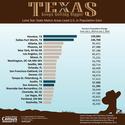From 2009-11, Americans seemed to be clustering again in dense cities, to the great excitement urban boosters. The recently released 2015 Census population estimates confirm that was an anomaly. Americans have strongly returned to their decades long pattern of greater suburbanization and migration to lower-density, lower-cost metropolitan areas, largely in the South, Intermountain West and, most of all, in Texas. read more »
Demographics
The Sun Belt Is Rising Again, New Census Numbers Show
- Login to post comments
The Relationship Between Fertility and National Income
We all heard that “demography is destiny”. But how many of us truly believe it? read more »
- Login to post comments
“Texas Keeps Getting Bigger” The New Metropolitan Area Estimates
The United States Census Bureau has just released its 2015 population estimates for metropolitan areas and counties. Again, the story is Texas, with the Bureau’s news release headline reading: Four Texas Metro Areas Collectively Add More Than 400,000 People in the Last Year. The Census Bureau heralded the accomplishment with a ”Texas Keeps Getting Bigger” poster, which is shown below. The detailed data is in the table at the bottom of the article. read more »
- Login to post comments
Farewell, Grand Old Party
The increased likelihood of Donald Trump as the GOP presidential nominee, as evidenced by his win in Florida and other states last week, spells the end of the Republican Party as we have known it. Successful political parties unite interests under a broadly shared policy agenda. The Clinton Democrats may seem ethically challenged, condescending and bordering on dictatorial, but they share basic positions on many core issues and a unifying belief in federal power as the favored instrument for change. read more »
- Login to post comments
Japan Census 2015: Decline Less than Projected
Headlines were recently made recently as Japan finally experienced a long predicted official decline in population. This is widely expected to be the beginning of a long decline in population, which the National Institute of Population and Social Security Research has projected will drop Japan’s population from its present 127 million to 43 million by 2100 (Chart). read more »
- Login to post comments
America’s Most Urban States
To the untrained eye, looking at a map of metropolitan America can lead one to the conclusion that at least half the nation’s land area is covered by urbanization. This is illustrated by Figure 1 below, which is a Census Bureau map of metropolitan areas as defined in 2013. These areas cover approximately 1.675 million square miles, which represents 47 percent of the US land area. read more »
- Login to post comments
Super Tuesday Analysis: How Race, Class And Geography Fed Trump And Clinton's Victories
After Tuesday night’s primary results, the presidential race is now all but settled among Democrats, and the fractured Republican field seems far along on their suicide mission to hand the White House to Hillary Clinton, a woman who as many as two-thirds of all Americans dislike, according to a recent poll. read more »
The Effect Race Could Have on the Race
Until now, the presidential campaign largely has been dominated by issues of class, driving the improbable rise of both Donald Trump and Bernie Sanders. But as we head toward Super Tuesday – which will focus largely on Southern states – racial issues may assume greater importance. read more »
"To the Suburb!" Lessons from Minorities and the New Immigrants
This essay is part of a new report from the Center for Opportunity Urbanism called "America's Housing Crisis." The report contains several essays about the future of housing from various perspectives. Follow this link to download the full report (pdf).
When I was in college the suburbs were vilified. It was the mid-2000s, and here we were, enlightened coeds having one last hurrah in the flat Midwestern expanse before finding our place in the world, and there really was only one world to find: the city. read more »
- Login to post comments
Hurdling the Obstacles to Millennial Home Ownership
Justin Chapman contributed research and editorial assistance to this piece. This essay is part of a new report from the Center for Opportunity Urbanism called "America's Housing Crisis." The report contains several essays about the future of housing from various perspectives. Follow this link to download the full report (pdf).
If the United States could remove current obstacles holding back members of the Millennial Generation from owning homes, the value of the housing market would increase by at least one trillion dollars over the next five years. Policies that would eliminate or sharply reduce financial obstacles that are currently hindering thirty somethings who want to start raising a family in the suburbs from buying a home would enable the construction and sale of as many as five million more homes between now and 2020. Residential investment represents about five percent of the country’s GDP, not counting the ancillary spending that results from such purchase. So any sound housing policy for the United States should begin and end with programs that allow these “missing Millennials” to join the ranks of America’s home owners. read more »
- Login to post comments






















